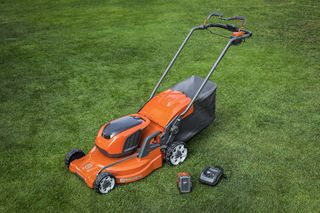What Type of Fuel Does a Lawn Mower Use? | Choosing the Right Fuel for Your Mower
When it comes to conquering lawn care, nothing quite beats the power and precision of the humble lawn mower. Since its creation almost two centuries ago, the lawn mower has undergone a remarkable transformation, evolving into the sleek and sophisticated workhorse we have today. Thanks to its unparalleled efficiency and versatility, the lawn mower remains the undisputed king of lawn care equipment.
To unleash the full potential of your mower, knowledge is key. How does your mower work? What type of fuel is best? How should you store lawn mower fuel?
By taking the time to learn these basics, you can take the hassle out of lawn care and enjoy a lush, healthy lawn year after year.
Choosing the right type of fuel
When it comes to combustible fuel, there are generally two types to choose from: petrol and ethanol-blended petrol (E10). Using the wrong type of fuel can lead to engine damage, decreased performance, and safety issues — which is why it’s important to know your fuels before getting started. Regardless of the type of fuel you choose, it's important to always use fuel that's fresh and has been properly stored. Here’s more about lawn mower fuel types and which one to choose.
Can I use E10 in my mower?
E10 fuel can be used in most petrol-powered lawn mowers, brush cutters and powered garden tools. If you choose to use E10 be sure to check the pump first as higher ethanol content fuels are not compatible
It's a good idea to use 100% unleaded petrol, especially toward the end of the mowing season. Ethanol draws moisture out of the air and into the fuel, causing it to stagnate. Both E10 and Unleaded petrol are fine — with unleaded being the better choice of the two.
How to store lawn mower fuel
How you store your lawn mower fuel will depend on the type you use. To prevent fuel contamination, it’s best to drain E10 fuels from your lawn mower before putting it away for extended periods.
The best way to store your fuel is in a clean, airtight Combi Can that’s clearly labeled to avoid any confusion with other fuels.
The different types of lawn mower engines
When it comes to lawn mowers, there are thousands of makes and models on the market. But out of all the options available, there are only two types of engine: petrol or electric.
4-stroke petrol engines like the LC 118 are the workhorses of the lawn care world, eliminating the need for any special fuel-oil mix requirements. They are also considered to be extremely reliable and popular for both large and small domestic gardens.
Battery-power engines like the one found on the LC 142i typically have a brushless motor powered by lithium-ion batteries — offering the ultimate in convenience. Cable-free and easy-to-manoeuvre electric engines offer additional benefits for those in built-up residential areas.

Petrol-powered lawn mowers
4-stroke engines are the most commonly used engines in petrol lawn mowers. The reason they are called 4-stroke engines is that their engine cycle consists of four strokes, resulting in the pistons making two full rotations for every four strokes. Unlike 2-stroke engines, 4-stroke engines have valves, a crankcase and a dedicated lubricating system, meaning you have both a fuel tank and an oil tank for the motor.
Pros of 4-stroke engines for lawn mowers
- More reliable engine with better torque.
- Fewer emissions and cleaner to run than 2-stroke engines.
- No need to mix oil and fuel to a set ratio.
- Lasts longer and is more fuel-efficient than 2-stroke.
Battery-powered lawn mowers
Battery-powered lawn mowers provide homeowners and greenspace professionals with a variety of benefits when compared to their petrol-powered counterparts, along with some standalone benefits too including:
- Zero exhaust emissions
- Fewer vibrations
- Lower noise levels
- Low weight designs
- No spark plugs or oil to change
- No air or fuel filters
- Cheaper to run
- Fewer working parts to maintain
- Quick battery switch out
How to store battery-powered lawn mowers
At the end of the mowing season, proper battery maintenance and storage will go a long way in improving the working life of your battery-powered mower. Here are a few tips to help you ensure your mower and battery are stored away properly over winter.
Battery Storage
- For the best service life, ensure any stored batteries are 50% charged.
- To check the status of your battery, press the button on the rear of it.
- If the battery is less than 50% charged, charge it to 50% before storing.
- The optimal storage temperature for Husqvarna batteries is 5-25°C.
Lawn Mower Storage
- Disconnect the battery from your mower and charge it to a minimum of 50% power.
- Remove any dry grass and debris from the cutting deck, inspect the blades for damage or corrosion.
- Wipe down the entire chassis with a microfibre cloth to remove any dirt.
- Place your lawn mower in a dry, low-humidity area such as in a utility room or ventilated garage.

Finding your perfect lawn mower
Whether you're looking to upgrade your current mower for something more modern, automate your lawn care with a robot mower, or switch to more advanced battery-power alternatives, Husqvarna has a lawn mower for every type of garden.
Not quite sure where to begin? Visit your local Husqvarna dealer or view the full product range online.
